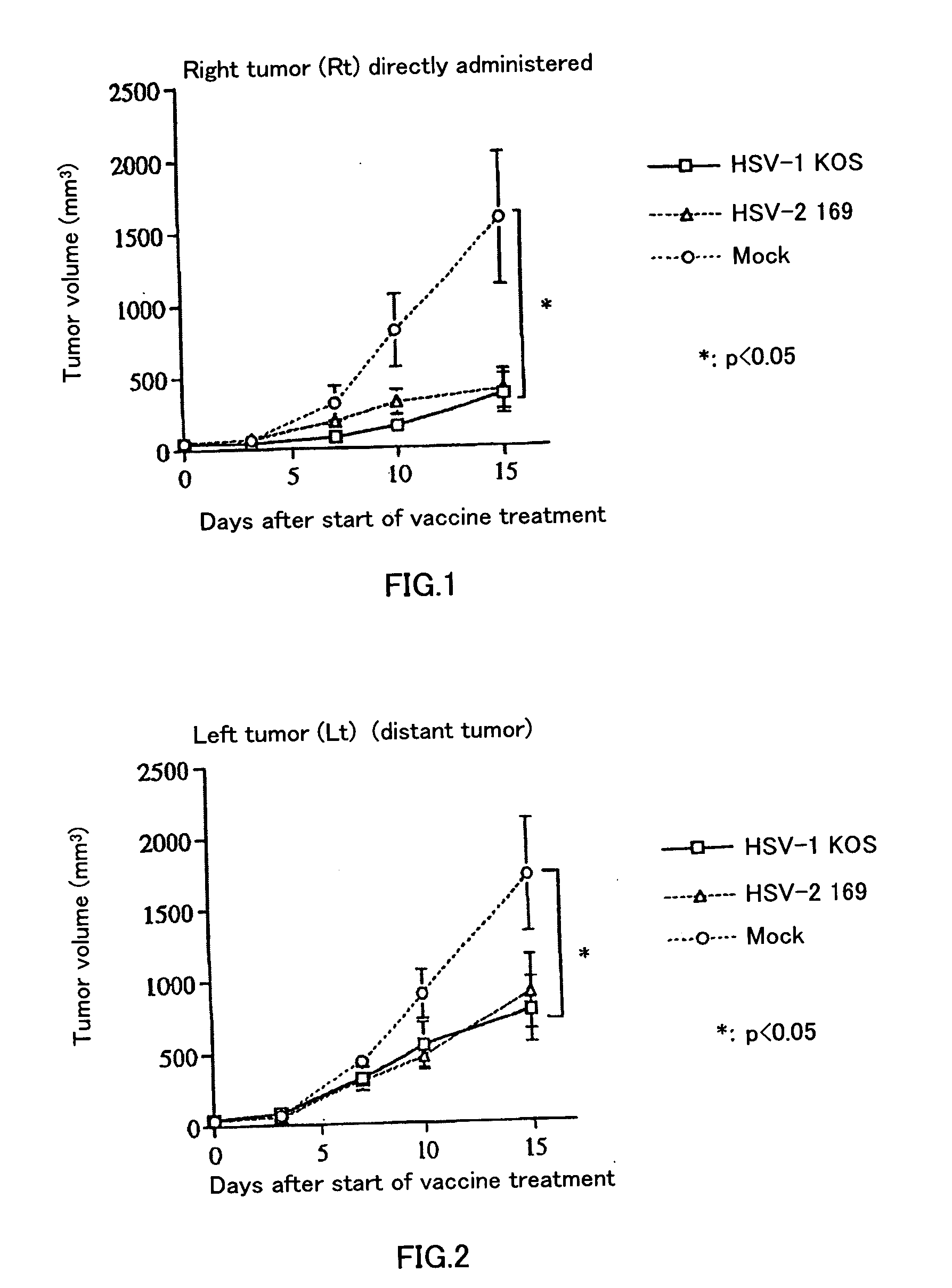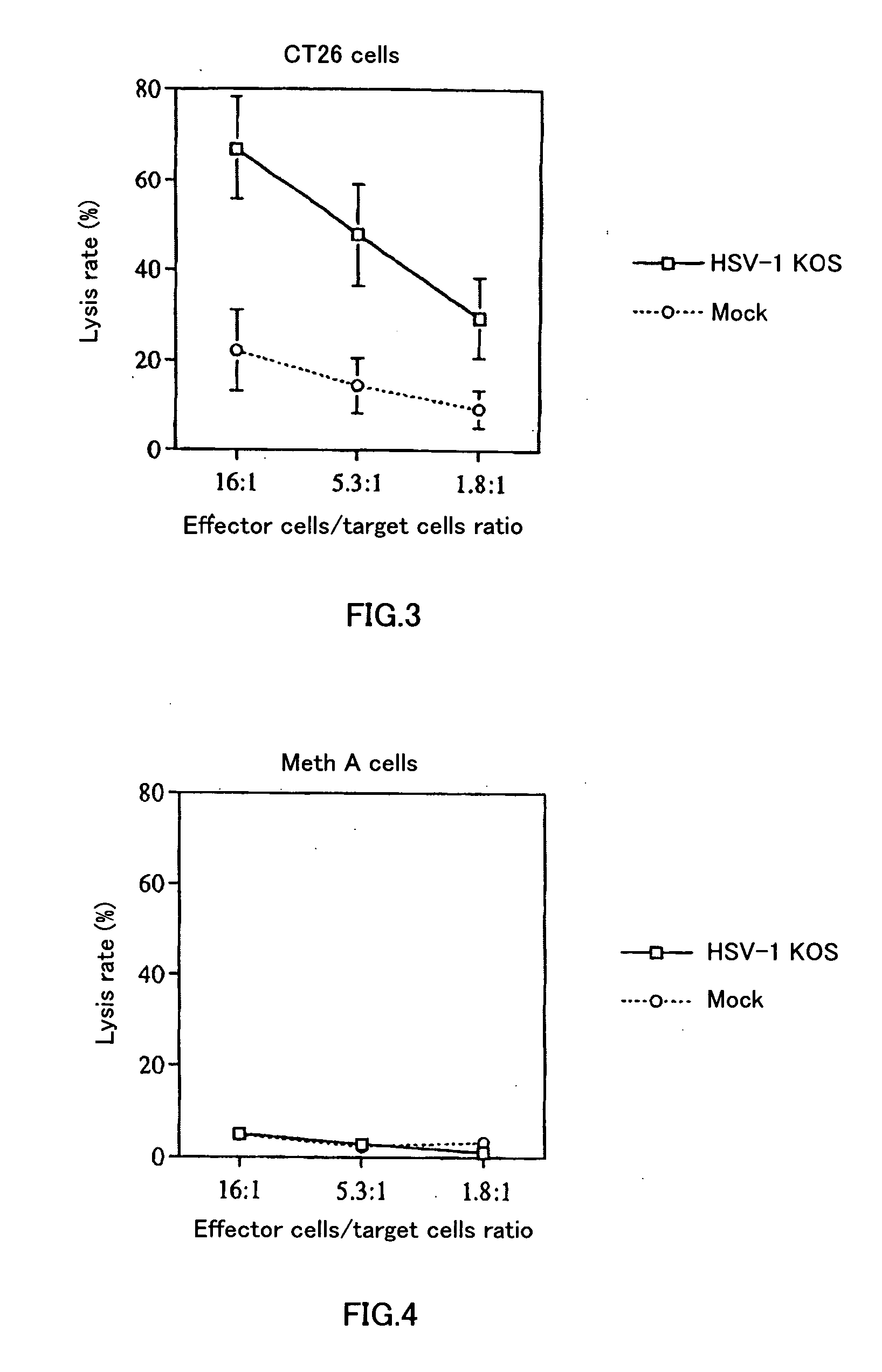Antitumor agents with the use of hsv
a technology of dendritic cell activator and anti-tumor agent, which is applied in the field of anti-tumor agent, tumor immunity inducer, t cell activator, and dendritic cell activator, can solve the problems of inability to use hsvgd for a cancer vaccine, pathologic condition that is extremely difficult to treat, and questionable side effects of hsvgd. , to achieve the effect of enhancing the antigen-presenting ability of dend
- Summary
- Abstract
- Description
- Claims
- Application Information
AI Technical Summary
Benefits of technology
Problems solved by technology
Method used
Image
Examples
example 1
Viruses, Cell Lines, and Proliferation
[0060] As viruses, the KOS strain of HSV-1 and the 169 strain of HSV-2 (provided by Dr. Yoshiko Seto) were used. African green monkey kidney Vero cells (purchased from ATCC) were used for proliferation of HSVs. Vero cells were cultured in Dulbecco's modified Eagle's medium (DMEM) supplemented with 10% heat-inactivated fetal calf serum (IFCS), and in DMEM supplemented with 1% IFCS when viruses were proliferating. After repeating freeze-thaw of the cells in the virus buffer (150 mM NaCl-20 mM Tris pH7.5) and ultrasonicating the extract, viruses were recovered from the supernatant.
example 2
Inactivation of HSV
[0061] Test HSVs were subjected to inactivation treatment by ultraviolet treatment and heat treatment. The infection efficiency of the HSVs used before inactivation was 2×108 plaque-formation units / ml. As inactivation by ultraviolet rays, the viruses were irradiated at 4 J / m2 for 30 min using 254 nm ultraviolet light on ice, according to the partly modified method of David C. J. et al. (J. virology, 62, 4605-4612, 1988). Subsequently, the UV-treated HSVs were subjected to heat treatment. As inactivation by heat treatment, thermal denaturation treatment of the HSVs were performed at 56° C. for 30 min according to the partly modified method of Hitsumoto Y et al. (Microbiol. Immunol., 27, 757-765, 1983).
example 3
In Situ Cancer Vaccine in a Mouse Bilateral Subcutaneous Tumor Model Using Inactivated HSV
[0062] Six to eight-week old female BALB / c mice were anesthetized (with 0.25 ml of anesthetic liquid: 84% saline, 10% pentobarbital [50 mg / ml], 6% ethanol), and then 5×105 CT26 cells / 100 μl was subcutaneously implanted bilaterally into mice. Treatment started when the diameter of the tumor reached about 5 mm. The extract of Vero cells used for virus preparation was UV-irradiated and heat-treated, and used as a control (hereinafter called “mock”). Either inactivated HSV or mock was administered only to the right tumor on days 0 and 3 after the start of treatment. Thereafter, the volumes of both of the tumors were periodically measured. Volume was calculated as major axis×(minor axis)2÷2. FIG. 1 shows the result of the periodical changes in tumor volume of the right tumor (Rt), into which CT 26 was directly administered (inoculated). FIG. 2 shows the result of the periodical changes in tumor vo...
PUM
 Login to View More
Login to View More Abstract
Description
Claims
Application Information
 Login to View More
Login to View More - R&D
- Intellectual Property
- Life Sciences
- Materials
- Tech Scout
- Unparalleled Data Quality
- Higher Quality Content
- 60% Fewer Hallucinations
Browse by: Latest US Patents, China's latest patents, Technical Efficacy Thesaurus, Application Domain, Technology Topic, Popular Technical Reports.
© 2025 PatSnap. All rights reserved.Legal|Privacy policy|Modern Slavery Act Transparency Statement|Sitemap|About US| Contact US: help@patsnap.com



